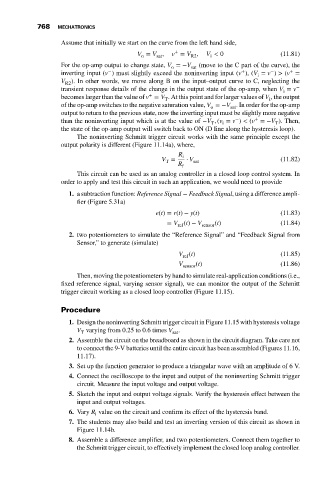Page 782 - Mechatronics with Experiments
P. 782
768 MECHATRONICS
Assume that initially we start on the curve from the left hand side,
+
V = V , v = V , V < 0 (11.81)
R2
o
sat
i
For the op-amp output to change state, V =−V sat (move to the C part of the curve), the
o
+
−
−
+
inverting input (v ) must slightly exceed the noninverting input (v ), (V = v ) > (v =
i
V ). In other words, we move along B on the input–output curve to C, neglecting the
R2
transient response details of the change in the output state of the op-amp, when V = v −
i
+
becomes larger than the value of v = V . At this point and for larger values of V , the output
T i
of the op-amp switches to the negative saturation value, V =−V . In order for the op-amp
o sat
output to return to the previous state, now the inverting input must be slightly more negative
−
+
than the noninverting input which is at the value of −V ,(v = v ) < (v =−V ). Then,
T i T
the state of the op-amp output will switch back to ON (D line along the hysteresis loop).
The noninverting Schmitt trigger circuit works with the same principle except the
output polarity is different (Figure 11.14a), where,
R i
V = ⋅ V sat (11.82)
T
R f
This circuit can be used as an analog controller in a closed loop control system. In
order to apply and test this circuit in such an application, we would need to provide
1. a subtraction function: Reference Signal − Feedback Signal, using a difference ampli-
fier (Figure 5.31a)
e(t) = r(t) − y(t) (11.83)
= V (t) − V (t) (11.84)
ref sensor
2. two potentiometers to simulate the “Reference Signal” and “Feedback Signal from
Sensor,” to generate (simulate)
V (t) (11.85)
ref
V sensor (t) (11.86)
Then, moving the potentiometers by hand to simulate real-application conditions (i.e.,
fixed reference signal, varying sensor signal), we can monitor the output of the Schmitt
trigger circuit working as a closed loop controller (Figure 11.15).
Procedure
1. Design the noninverting Schmitt trigger circuit in Figure 11.15 with hysteresis voltage
V varying from 0.25 to 0.6 times V .
T sat
2. Assemble the circuit on the breadboard as shown in the circuit diagram. Take care not
to connect the 9-V batteries until the entire circuit has been assembled (Figures 11.16,
11.17).
3. Set up the function generator to produce a triangular wave with an amplitude of 6 V.
4. Connect the oscilloscope to the input and output of the noninverting Schmitt trigger
circuit. Measure the input voltage and output voltage.
5. Sketch the input and output voltage signals. Verify the hysteresis effect between the
input and output voltages.
6. Vary R value on the circuit and confirm its effect of the hysteresis band.
i
7. The students may also build and test an inverting version of this circuit as shown in
Figure 11.14b.
8. Assemble a difference amplifier, and two potentiometers. Connect them together to
the Schmitt trigger circuit, to effectively implement the closed loop analog controller.

